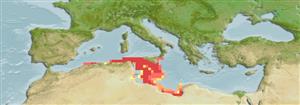sub class Elasmobranchii (ฉลามและกระเบน) (sharks and rays) >
Rajiformes (Skates and rays) >
Rajidae (Skates)
Etymology: Leucoraja: Greek, leykos = white + Latin, raja = a fish, Raja sp. (Ref. 45335).
Environment: milieu / climate zone / ระดับความลึก / distribution range
นิเวศวิทยา
เกี่ยวกับทะเล,น้ำเค็ม สัตว์หน้าดินในเขตน้ำลึก; ระดับความลึก 60 - 800 m (Ref. 106604). Deep-water; 42°N - 36°N, 2°W - 16°E
Mediterranean Sea: endemic to the coasts of Tunisia, Malta and a single record from Italy; rare off Algeria.
ขนาด / น้ำหนัก / Age
วัยเจริญพันธุ์: Lm ? range ? - ? cm
Max length : 52.0 cm TL เพศผู้/กระเทย; (Ref. 125195); 45.0 cm TL (female)
Feed on crustaceans mainly amphipods (Ref. 3167). Oviparous. Distinct pairing with embrace. Young may tend to follow large objects, such as their mother (Ref. 205). Eggs are oblong capsules with stiff pointed horns at the corners deposited in sandy or muddy flats (Ref. 205). About 10-56 eggs are laid per individual annually (Ref. 41305, 41314).
Oviparous, paired eggs are laid. Embryos feed solely on yolk (Ref. 50449). Breeds throughout the year, but ripe females observed mainly in spring and autumn (Ref. 3167). Distinct pairing with embrace. Young may tend to follow large objects, such as their mother (Ref. 205).
McEachran, J.D. and K.A. Dunn, 1998. Phylogenetic analysis of skates, a morphologically conservative clade of elasmobranchs (Chondrichthyes: Rajidae). Copeia 1998(2):271-290. (Ref. 27314)
IUCN Red List Status (Ref. 130435: Version 2025-1)
Threat to humans
Harmless
Human uses
การประมง: มีการค้าเพียงเล็กน้อย
เครื่องมือ
Special reports
Download XML
แหล่งที่มาจากอินเตอร์เน็ต
Estimates based on models
Preferred temperature (อ้างอิง
123201): 13.1 - 14.6, mean 14 °C (based on 23 cells).
Phylogenetic diversity index (อ้างอิง
82804): PD
50 = 0.5000 [Uniqueness, from 0.5 = low to 2.0 = high].
Bayesian length-weight: a=0.00229 (0.00142 - 0.00370), b=3.21 (3.07 - 3.35), in cm total length, based on LWR estimates for this species & Genus-body shape (Ref.
93245).
ระดับชั้นอาหาร (อ้างอิง
69278): 3.3 ±0.53 se; based on food items.
ความสามารถในการกลับคืนสู่ปกติ (อ้างอิง
120179): ต่ำ, เวลาต่ำสุดที่จะทำให้ประชากรเพิ่มขึ้นเป็น 2 เท่าใช้เวลา 4.5 - 14 ปี (Fec=10).
Fishing Vulnerability (Ref.
59153): Moderate vulnerability (41 of 100).
🛈
Nutrients (Ref.
124155): Calcium = 6.32 [0.98, 122.77] mg/100g; Iron = 0.346 [0.033, 4.702] mg/100g; Protein = 15.1 [13.0, 17.2] %; Omega3 = 0.455 [0.180, 1.150] g/100g; Selenium = 14.5 [2.5, 68.7] μg/100g; VitaminA = 5.07 [0.37, 64.27] μg/100g; Zinc = 0.329 [0.023, 3.815] mg/100g (wet weight);
